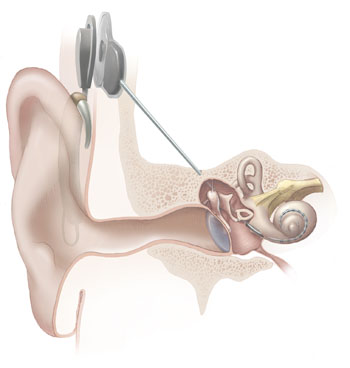Improving cochlear impants
Interview with
Cochlear implants are electrical devices that consist of a system of tiny  implantable electrodes that can directly activate "hearing nerves" in the inner ear or "cochlea" to treat deafness.
implantable electrodes that can directly activate "hearing nerves" in the inner ear or "cochlea" to treat deafness.
But only a restricted set of sounds can be signalled this way because the nerves are difficult to activate.
Now, University of New South Wales scientist Gary Housley and his colleagues have found that electricity from the cochlear implant can be used to make cells in the inner ear pick up short pieces of DNA coding for a gene for a nerve growth signal, called BDNF that can be injected into the ear.
This, in turn, makes the hearing nerves grow and become much more sensitive to signals from the cochlear implant, with the potential to dramatically improve the quality of the hearing experience.
Gary - The cochlea or our hearing organ converts sounds of different frequencies into information that's encoded in the auditory nerve fibres which then transmit that information to the auditory processing centres in the brain. There are about 4,000 cells called hair cells and they have these little hair-like processes on the tops of them and they respond to the vibrations produced by sound and release neurotransmitter that stimulates the auditory neurons.
Chris - And when a person goes deaf, what's gone wrong with the cochlea structure in those people?
Gary - Typically, it's the hair cells that are the most vulnerable. When the hair cells are lost, then in fact, the cells around them also seem to die. With that, they stop the production of, if you like, a hormone or a chemical that sustains the auditory nerve fibres then the auditory nerve fibre dies back. That's the state that the cochlea lies in if you like, at the point where people become severely hearing impaired and perhaps, a cochlear implant might provide a possible means of restoring a degree of hearing to those people.
Chris - When someone has a cochlear implant fitted, how does it work to restore hearing to those areas that have become hard of hearing?
Gary - A cochlear implant typically consists of 22 or fewer electrodes. What they do is by passing current from those electrodes out through the cochlea tissue, they're able to electrically stimulate and excite those auditory neurons. When those neurons fire their action potentials again, people can actually perceive sound.
Chris - So, how have you sought to improve the situation?
Gary - Well, we have tried to find the means to regenerate those auditory neurons, get the nerve fibres to a point where they're much more easily stimulated and therefore, give a broader and richer hearing experience.
Chris - How do you think you can do that?
Gary - Through gene therapy, it's possible to get cells to synthesise and release nerve maintenance factors - the neurotrophins - that have been lost when the hair cells died if you like. We use the cochlear implant to provide very short electrical pulses which were effective in actually driving the DNA into cells that were very close to the electrodes to make the nerve fibres head to those electrodes.
Chris - How do you get the DNA for the growth factor into the area in the cochlea where you want to use the electricity from the cochlear implant to get it into the adjacent cells?
Gary - We produce the DNA which codes for the sprain derived neurotrophic factor and we're able to inject that into the cochlea and then we pass the few electrical pulses and literally, within 5 seconds, we've been able to create small pores in cells that are very close to the electrodes. They take up the DNA and then in short order, they start producing the neurotrophin and within a few days, the auditory nerve fibres are growing back out and towards the electrodes.
Chris - Is this a permanent change or is this just temporary, this nerve response?
Gary - Using imaging techniques, we could see these new outgrowths for up to 3 months after our gene therapy. But by the time we'd gone out to 12 weeks, there were far fewer of these nerve fibres. So, what is clear to us at the moment is that, the expression is waning. So, this certainly would something we would want to look at and potentially find a means of sustaining the gene therapy for a longer period of time.
Chris - If you make measurements after these nerve cells have grown in this way in response to the nerve growth factor that you've expressed, does this translate into more sensitive hearing in your experiments?
Gary - Well, I think that was the really exciting point. With the regeneration that we achieved, we're able to then make a functional assessment of potential for improved hearing. The technique that we used for that is very similar to the technique that's used very broadly for newborn baby screening. It's called auditory brain stem response. We passed small currents through the cochlear implant, gradually step-up the amount of current that we're passing until, we're able to record a brainwave. With our gene therapy, we established that much smaller currents could be used to elicit a response. And then as we increase the amount of current, we got progressively greater increase in the output in those auditory centres in the brain.
- Previous Living to 115
- Next The Madingley Ecosystem Model










Comments
Add a comment